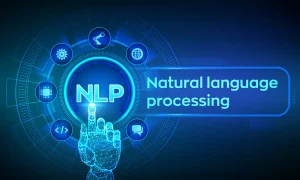What is NLP? :
Natural language processing (NLP) is a subfield of computer science and artificial intelligence (AI) that uses machine learning to enable computers to understand and communicate with human language.
NLP enables computers and digital devices to recognize, understand and generate text and speech by combining computational linguistics—the rule-based modeling of human language—together with statistical modeling, machine learning (ML) and deep learning.
NLP research has enabled the era of generative AI, from the communication skills of large language models (LLMs) to the ability of image generation models to understand requests. NLP is already part of everyday life for many, powering search engines, prompting chatbots for customer service with spoken commands, voice-operated GPS systems and digital assistants on smartphones.
NLP also plays a growing role in enterprise solutions that help streamline and automate business operations, increase employee productivity and simplify mission-critical business processes.
Benefits of NLP :
A natural language processing system can work rapidly and efficiently: after NLP models are properly trained, it can take on administrative tasks, freeing staff for more productive work. Benefits can include:
Faster insight discovery: Organizations can find hidden patterns, trends and relationships between different pieces of content. Text data retrieval supports deeper insights and analysis, enabling better-informed decision-making and surfacing new business ideas.
Greater budget savings: With the massive volume of unstructured text data available, NLP can be used to automate the gathering, processing and organization of information with less manual effort.
Quick access to corporate data: An enterprise can build a knowledge base of organizational information to be efficiently accessed with AI search. For sales representatives, NLP can help quickly return relevant information, to improve customer service and help close sales.
The process of Natural Language Processing (NLP) involves several key steps, from data collection to deployment. Here’s a comprehensive outline of the NLP process:
1. Data Collection
- Source Identification: Gather text data from various sources like books, articles, social media, chat logs, etc.
- Data Acquisition: Use web scraping, APIs, or databases to collect the text data.
2. Text Preprocessing
- Tokenization: Splitting text into individual tokens (words, phrases).
- Lowercasing: Converting all characters to lowercase to ensure uniformity.
- Stop Words Removal: Removing common words (e.g., “the”, “is”) that do not contribute much to the meaning.
- Punctuation Removal: Eliminating punctuation marks.
- Stemming/Lemmatization: Reducing words to their base or root form (e.g., “running” to “run”).
- Noise Removal: Cleaning text by removing special characters, numbers, or irrelevant information.
- Normalization: Handling variations in text (e.g., converting “U.S.” and “USA” to a standard form).
3. Text Representation
- Bag of Words (BoW): Representing text as a set of word frequencies.
- TF-IDF (Term Frequency-Inverse Document Frequency): Weighing terms based on their frequency in a document relative to their frequency in the entire corpus.
- Word Embeddings: Using dense vector representations of words that capture semantic relationships (e.g., Word2Vec, GloVe, FastText).
- Contextual Embeddings: Using advanced models like BERT, ELMo, or GPT that capture context-dependent meanings of words.
4. Feature Engineering
- N-grams: Creating sequences of N words to capture context (e.g., bigrams, trigrams).
- Part of Speech (POS) Tagging: Identifying the grammatical parts of speech in the text.
- Named Entity Recognition (NER): Identifying and classifying entities (e.g., names, dates, locations).
- Dependency Parsing: Understanding the grammatical structure of a sentence and the relationships between words.
- Sentiment Analysis: Determining the sentiment expressed in the text (e.g., positive, negative).
5. Model Building
- Selection of Algorithms: Choosing appropriate machine learning or deep learning algorithms (e.g., Logistic Regression, Naive Bayes, SVM, RNN, LSTM, Transformer-based models like BERT).
- Training: Feeding the preprocessed and represented text into the selected algorithm to learn patterns and make predictions.
6. Model Training
- Data Splitting: Dividing the data into training and testing sets.
- Training Process: Using the training set to teach the model by adjusting weights to minimize the loss function.
- Validation: Evaluating the model on a validation set to tune hyperparameters and avoid overfitting.
7. Model Evaluation
- Metrics: Assessing model performance using metrics like accuracy, precision, recall, F1 score, and confusion matrix.
- Cross-Validation: Performing cross-validation to ensure the model’s robustness and generalizability.
8. Hyperparameter Tuning
- Grid Search/Random Search: Testing different hyperparameter values to find the best combination.
- Automated Tuning: Using automated methods like Bayesian optimization for hyperparameter tuning.
9. Inference and Prediction
- Applying the Model: Using the trained model to make predictions on new, unseen data.
- Post-processing: Refining the model outputs to meet the application’s requirements (e.g., converting predictions back to readable text).
10. Deployment
- Model Integration: Integrating the model into the desired application (e.g., web app, mobile app, API).
- Scalability: Ensuring the model can handle real-time data and large volumes of requests.
11. Monitoring and Maintenance
- Performance Monitoring: Continuously monitoring the model’s performance in production.
- Data Drift: Detecting and addressing changes in data patterns that could affect model performance.
- Model Retraining: Regularly updating the model with new data to maintain accuracy and relevance.

